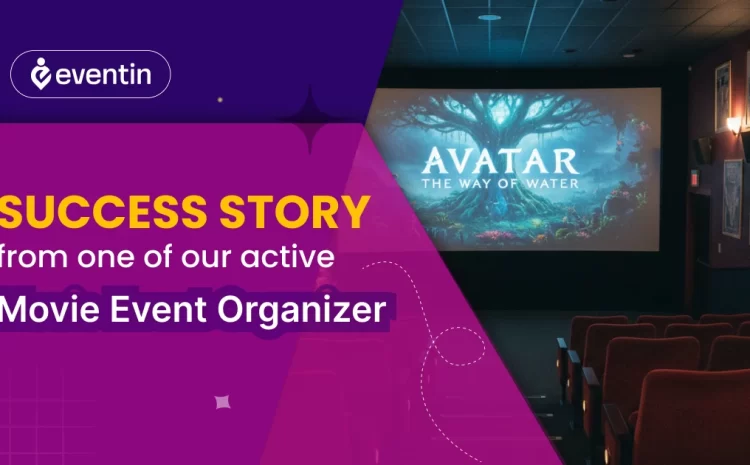Is WordPress Dying? The State of WordPress in 2025 (& What Comes Next)
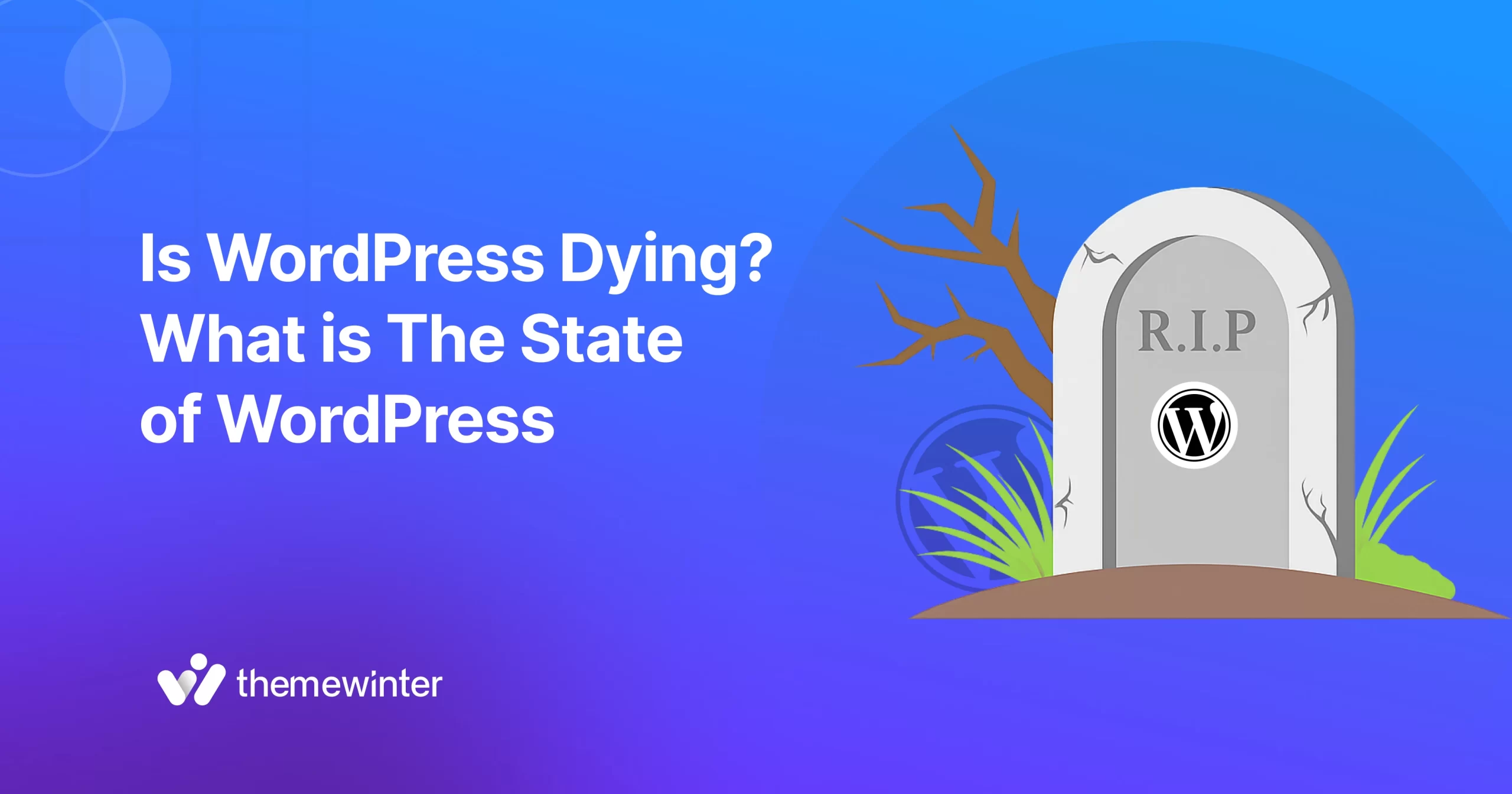
Table of Contents
If you’ve been in WordPress groups or tech forums, you’ve probably seen the question: “Is WordPress dying?”
It’s not a new conversation. Every few years, a new tool or trend sparks rumours that WordPress is outdated, bloated, or on its way out.
With platforms like Webflow, Framer, Shopify, and Ghost gaining traction, it’s understandable that people — primarily developers, freelancers, and business owners — begin to wonder whether WordPress remains a viable option in 2025.
But is that really the whole picture?
In this article, we’ll look at what is the state of WordPress in 2025, what’s changing, what’s not, and whether it’s still worth using.
Let’s get started.
🎥 Watch: Is WordPress Really Dying in 2025?
Don’t feel like reading the full post? Watch this quick video that explains the real state of WordPress backed by data, trends, and what’s next in 2025.
Why do people think WordPress is dying?
Many people have strong opinions about WordPress, especially from those who have either struggled with it or moved on to something else. Although it still has many users, some believe it’s starting to lose its position.
1. It’s getting outdated
WordPress has been around for over 20 years. While it’s powerful, the dashboard can feel outdated compared to newer tools with visual editors. Even with the Gutenberg block editor, there’s still a learning curve, especially for beginners.
2. Saturated plugin and theme market
WordPress owes much of its flexibility to plugins, but that’s also one of its weaknesses. Even for basic features, it often requires installing plugins. More plugins mean more updates, more settings to manage, and a higher chance of things breaking if they don’t play well together. All of this makes some people feel like WordPress hasn’t kept up.
3. Security concerns
WordPress is a popular target for hackers primarily because it is widely used. Additionally, outdated plugins, themes, or poor hosting configurations can render sites vulnerable. While many of these issues are preventable, the idea that WordPress isn’t secure still sticks with some people.
4. The alternatives are on the rise
Platforms like Webflow, Framer, Ghost, Shopify, and Wix offer clean, all-in-one experiences with visual editors. You don’t need to install plugins or set anything up, just log in and start building. For users who want something quick and simple, these tools feel easier and more modern than WordPress.
5. Legacy code frustrates developers
Some developers believe that WordPress is outdated because it still relies on older PHP versions and requires support for legacy setups. Compared to newer frameworks or headless CMSs, it can feel limited or messy, especially when building custom features from scratch.
6. Declining market share
WordPress once powered nearly 65% of all websites using a content management system. As of July 2025, that number has dropped to 60.9%. That’s still the majority, but the slow decline has made some people question its future.
What’s actually happening: The real state of WordPress in 2025
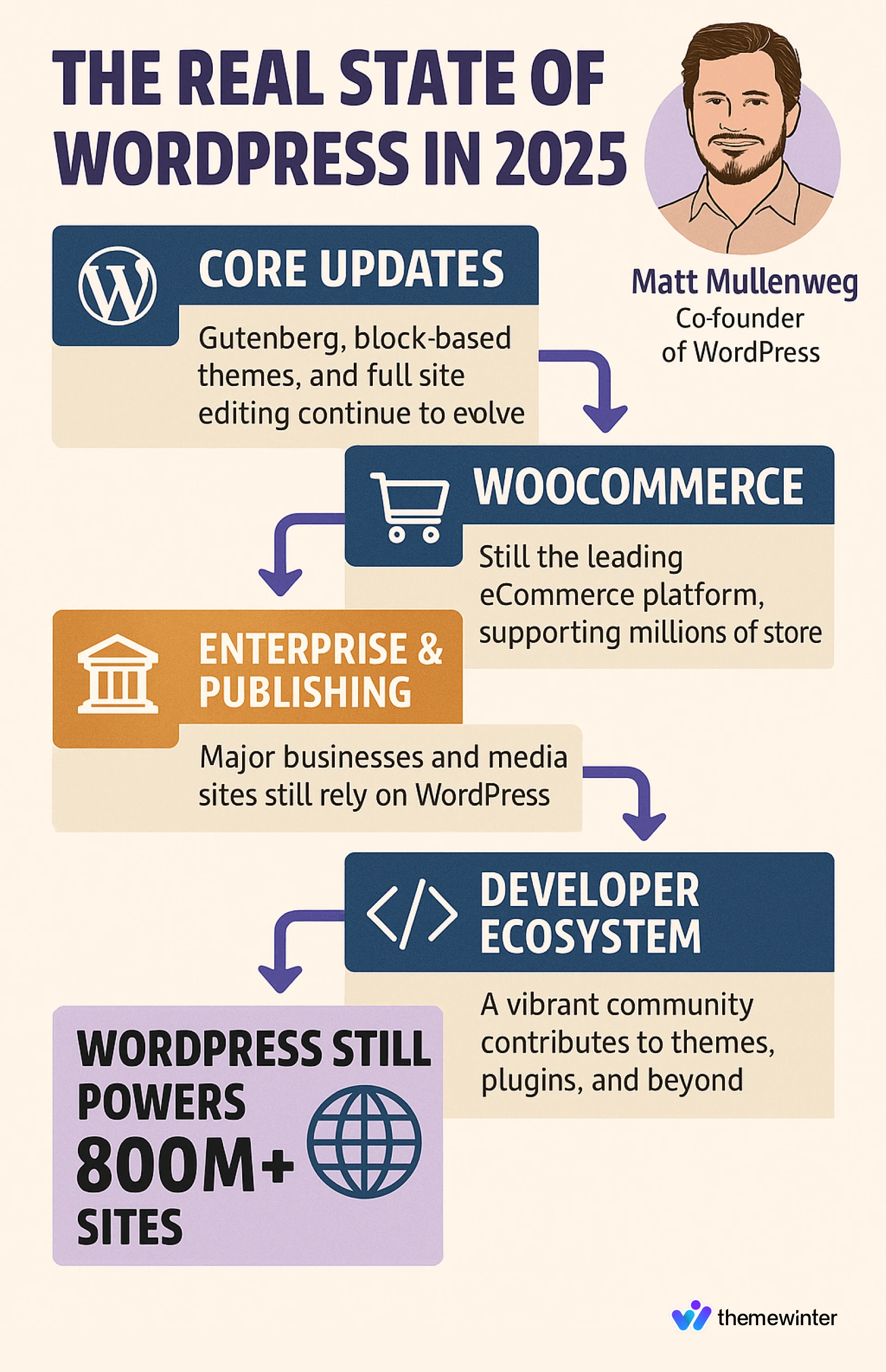
Despite the buzz surrounding newer tools, WordPress continues to quietly power a significant portion of the internet. While it might not be the “shiny new thing,” the platform is still active, improving, and widely used across blogs, business sites, and online stores.
Let’s take a closer look.
WordPress core updates are still active (Gutenberg, Blocks, FSE)
The WordPress team hasn’t slowed down. Core development is ongoing, and significant updates continue to roll out, especially around Gutenberg (the block editor that’s become a central part of the WordPress experience).
In 2025, we’re deep into Gutenberg Phase 3, which brings enhanced collaboration tools, smoother editing, and greater control over how a site looks and functions.
Full Site Editing has come a long way. Block themes are now more stable, and you can change layouts, headers, and footers without needing a page builder. It’s not perfect yet, but it’s improving with every update.
WooCommerce still dominates eCommerce
While Shopify receives a lot of attention, WooCommerce remains the most widely used e-commerce platform on the web. It integrates deeply with WordPress, is open-source, and offers complete ownership of your store, something many business owners still value.
In 2025, WooCommerce has improved its onboarding process, performance, and integration with modern payment and shipping tools. With better themes, block editing, and easier payments and shipping, it remains a solid choice for many online stores.
Major publishers and businesses still rely on WP
WordPress isn’t just for personal blogs or small businesses. Big publishers, universities, and even nonprofits still use it to run busy, content-heavy websites. This includes everything from news sites and universities to enterprise portals and global nonprofit organizations.
They’re not sticking with WordPress just because they’ve always used it; they’re choosing it because it works. It’s flexible, scalable, and supported by a vast ecosystem of tools and developers.
The developer ecosystem is still strong
WordPress has one of the most active and supportive communities in tech. From independent plugin creators to full-service agencies, the WordPress developer ecosystem continues to thrive. Tools like WP-CLI, ACF, and newer block-based development frameworks are making it easier to build modern WordPress sites.
There’s also growing interest in headless WordPress setups, where WordPress is used as a backend CMS with frontend frameworks like React or Next.js. This enables developers to integrate WordPress’s content management capabilities with modern performance and user experience.
WordPress still powers 810M+ sites
As of mid-2025, WordPress remains the leading content management system, powering over 43.3% websites worldwide. That’s a considerable share. While its market share has shifted slightly with the rise of other platforms, none come close to WordPress in terms of the number of sites it powers worldwide.
Top websites built with WordPress
Many well-known websites utilize WordPress as their content management system. A few examples include TechCrunch, The Walt Disney Company, Sony Music, and Reuters.
You’ll also find WordPress behind sites like The White House, Time Magazine, and the CNN Press Room. In addition to these, major brands such as Mercedes-Benz and Facebook Newsroom also utilize WordPress.
In June 2025, Automattic confirmed it had reversed a four‑month pause and would fully re‑engage with development on WordPress Core, Gutenberg, Openverse, and WordPress.org.
The pause in contributions came at a critical moment, as competitors outpaced WordPress in ease of use and technological innovation.
– Search Engine Journal
WordPress by the numbers (2025 data snapshot)
Numbers don’t tell the whole story, but they offer a solid foundation for understanding how WordPress is performing in 2025 and who is still using it.
Here are some updated statistics to provide a clear picture.
CMS market share stats
According to W3Techs, WordPress powers 43.3% of all websites and holds a 60.9% market share in the CMS sector. That’s still the highest by far, more than all other CMS platforms combined. While newer tools like Shopify (6.8%) and Wix (5.5%) are growing, they still trail far behind.
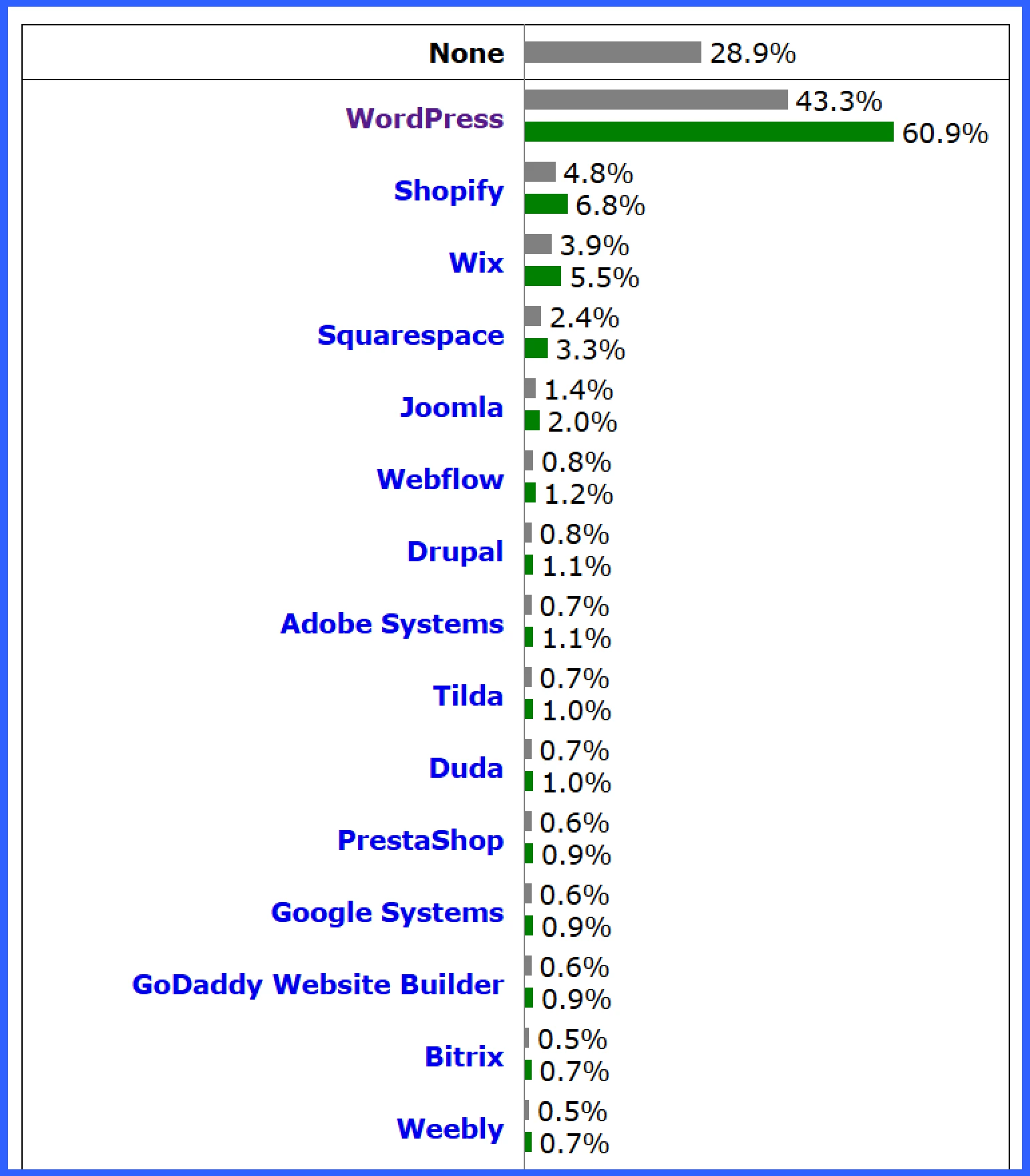
Over the past few years, WordPress’s market share has dropped slightly from its peak in 2021 (64.1%), but its overall presence remains strong.
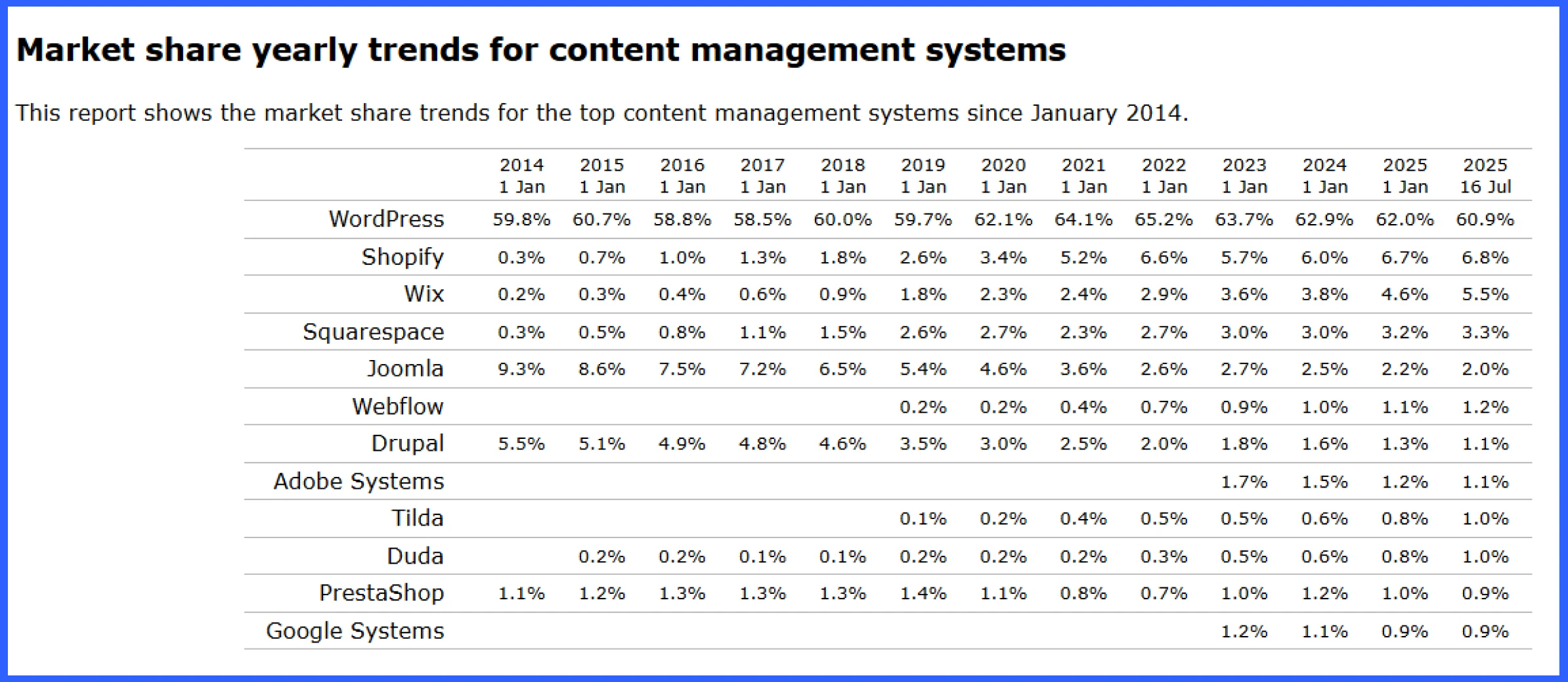
WordPress in Google Trends
If you look at the Google Trends graph, you’ll see that WordPress searches peaked around 2014. Since then, the search volume has decreased slightly, but it remains strong.
When you add options like Wix and Shopify to the graph, you’ll see that WordPress still has more search interest than any other CMS.
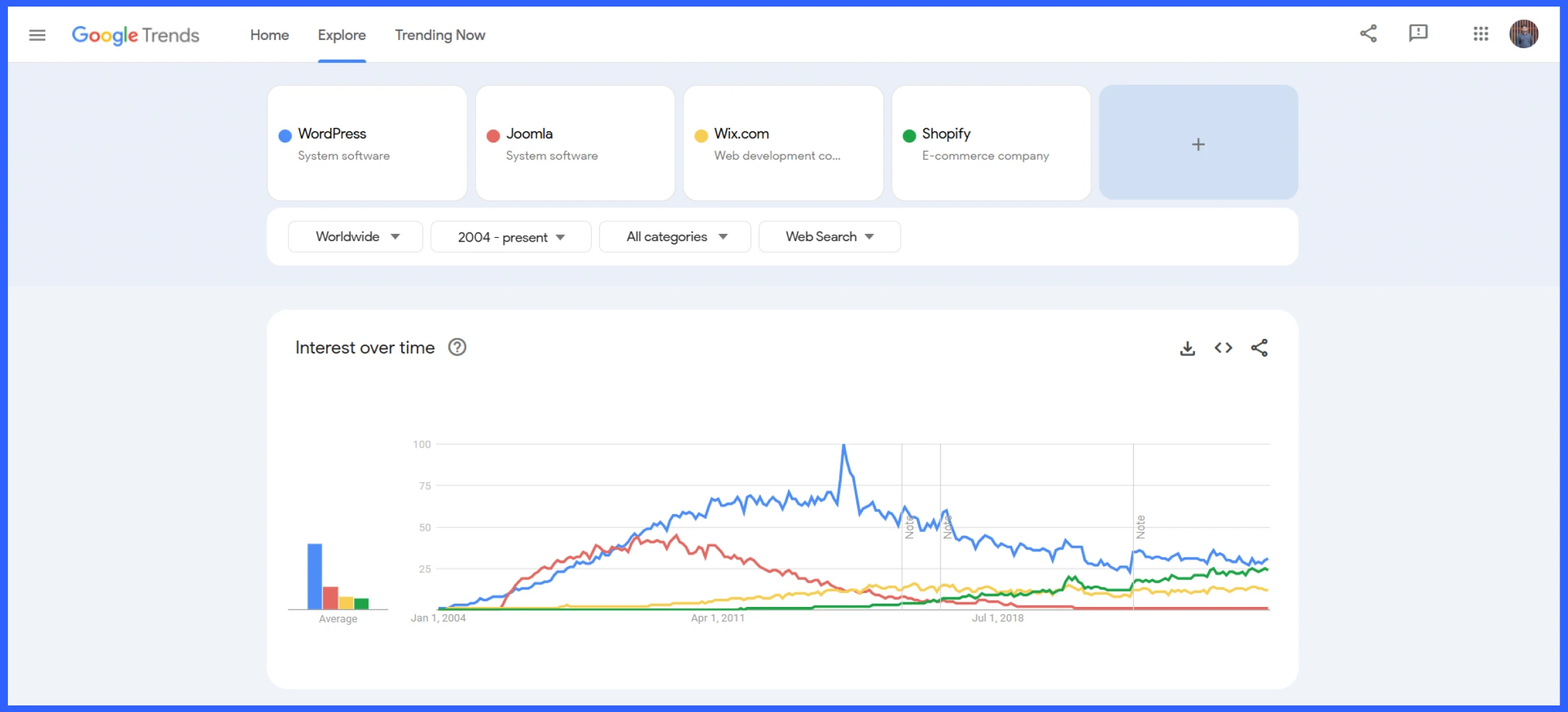
WordPress plugins and themes stats
WordPress.org now lists over 73,000 free plugins and themes. In 2025 alone, there have already been 7,670 new plugin submissions, marking an 87% increase compared to the previous year (shared at WordCamp US 2025 by Ma.tt Mullenweg).
Popular plugins such as Elementor and Yoast continue to maintain millions of active installations. At the same time, thousands of free themes like Astra and Kadence give users endless options to customize their WordPress sites.

WooCommerce adoption stats
WooCommerce is used by 12.5% of all CMS-based websites, which account for approximately 8.9% of all websites on the internet, according to W3Techs.
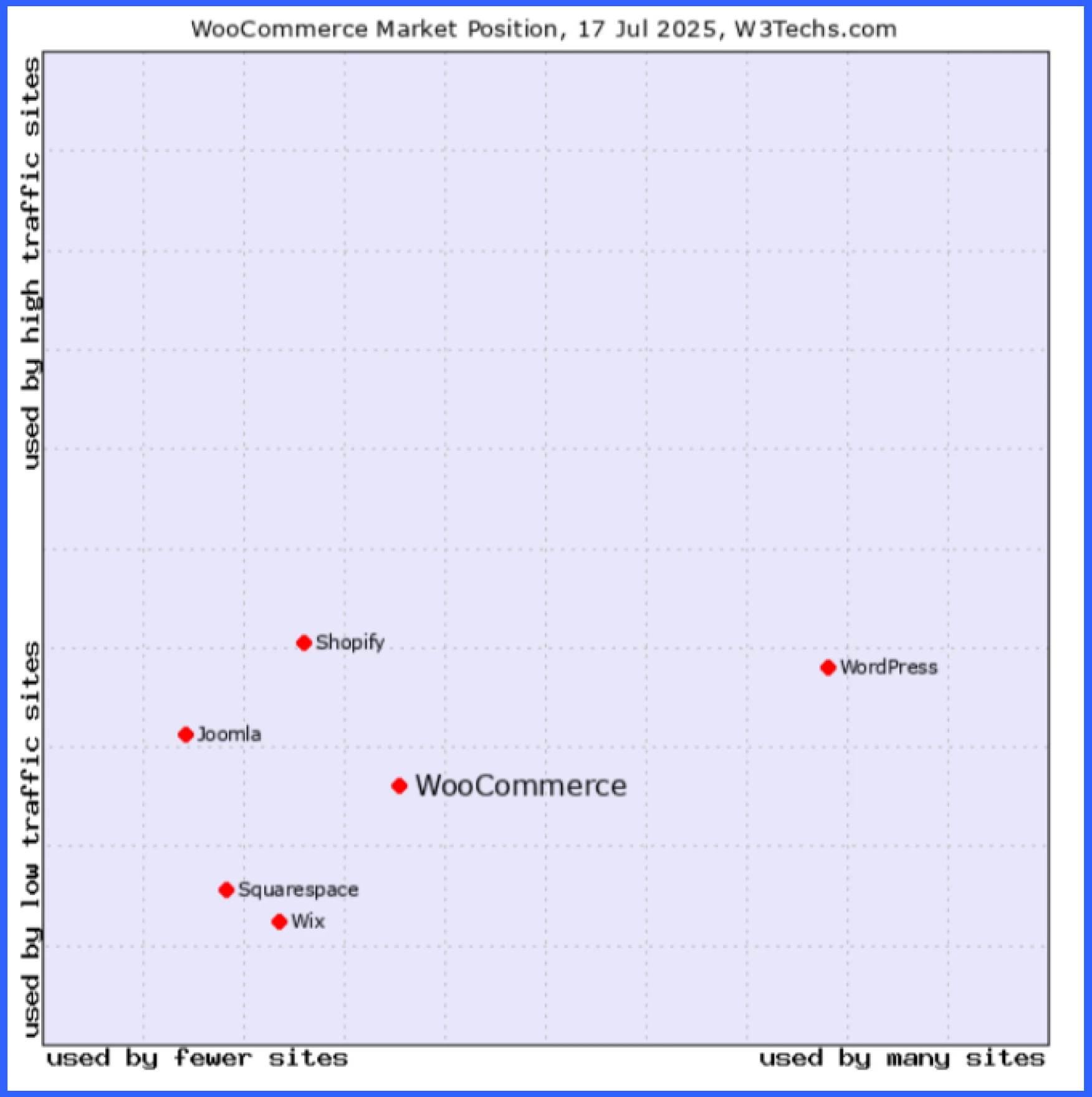
Growth in block themes and full site editing
More developers are shifting to block-based themes. As of early 2025, the WordPress directory now features over 1,300 block themes, nearly double the number compared to last year.
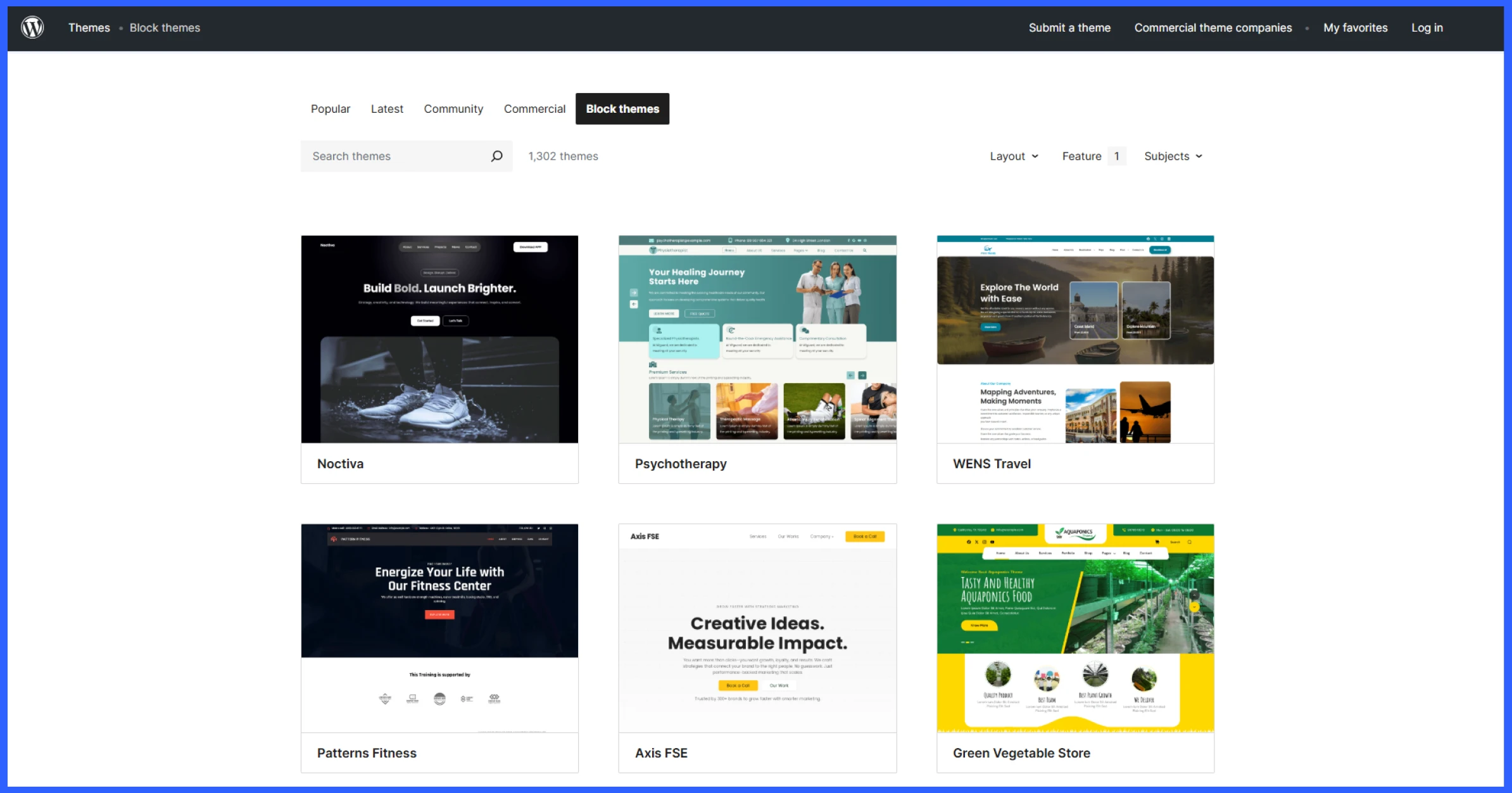
WordPress.com vs WordPress.org usage trends
WordPress.org remains the preferred choice for self-hosted sites. But WordPress.com is also improving. In fact, WordPress.com has introduced new pricing plans and full-site editing tools to support creators and freelancers.
It’s not replacing .org, but it’s becoming a more viable option for solo creators and small teams.
Who is moving away from WordPress and why
Even though WordPress still powers a massive number of websites, it’s also true that some users have chosen other platforms. Let’s look at who’s making that move and what’s behind it.
- Small businesses wanting no-code, quick setups: Many small business owners prefer not to deal with plugins, hosting, or updates. They just want something simple that works out of the box. Tools like Wix, Shopify, and Webflow give them a clean design, simple setup, and fewer moving parts. For basic websites, that’s often enough.
- Creators seeking focused tools: Writers and newsletter creators are turning to platforms like Substack or Ghost. Designers and portfolio sites are picking Framer. Compared to WordPress, they’re more focused. You don’t need to install extra plugins or configure settings to get started. That simplicity can be a big draw.
- Agencies exploring headless and Jamstack setups: Some development teams and agencies have moved to headless CMS setups or JAMstack architectures because they want more control over performance and frontend design.
Interestingly, many users who leave WordPress eventually come back, especially when they run into limits on other platforms. A no-code tool might be easy to use, but it can also be hard to customize.
That’s where the open-source nature of WordPress really helps. You’re not locked into a pricing plan or one provider. You can switch hosts, build custom features, and shape things the way you need if you’re willing to put in the time.
A brand‑new AI team is working within core development, after competitors had already integrated AI tools, along with plans to include AI‑driven features in the upcoming WordPress 6.9 release. – Search Engine Journal
Who still uses WordPress in 2025 and why it works
While some folks move away, many still rely on WordPress every day. These are the people and businesses that continue to get real value from it.
Here’s a look at who’s sticking with WordPress and why it still makes sense.
1. Agencies running client projects
For web agencies that work with a diverse range of clients, WordPress remains a reliable choice. It’s flexible, well-documented, and widely supported. Whether they’re building a site for a restaurant, a nonprofit, or a local service provider, agencies can usually find a plugin, theme, or developer to help get the job done.
Clients also benefit from WordPress’s familiarity. Once a site is built, it’s easy for teams to take over content updates or blog management without needing to learn a new system from scratch.
2. Content-focused blogs and seo sites
If your goal is to publish content, WordPress remains a viable option for doing so. It’s built with blogging in mind and has strong support for custom taxonomies, categories, SEO plugins, and long-form content.
Tools like Yoast SEO, Rank Math, and Schema plugins help users optimize their websites for search engines, while custom post types provide flexibility in how content is organized and displayed. For SEO-driven websites, it’s hard to beat the control that WordPress offers.
3. eCommerce shops using WooCommerce
WordPress and WooCommerce remain a solid choice for many online stores, particularly if you want more control over how your shop operates. Whether you’re selling physical products, running subscriptions, or offering memberships, it gives you the flexibility to build what you need.
Unlike hosted platforms, WooCommerce doesn’t tie you to specific payment options or fixed monthly plans. You can choose the tools and services that fit your workflow.
4. Event managers, booking businesses, and teaching platforms
WordPress excels in specialized use cases, such as event management, booking systems, event registration, course sales, and online learning. Plugins like Eventin, Booktics, and Tutor LMS offer ready-to-go solutions that can be customized as needed.
This flexibility means WordPress is still widely used by:
- Schools and training programs
- Coaches and consultants offering appointments
- Event organizers manage ticket sales and attendee lists
- Creating multivendor event marketplace
Other platforms simply don’t offer this level of versatility without custom development.
Where WordPress is thriving in 2025 (real-world use cases)
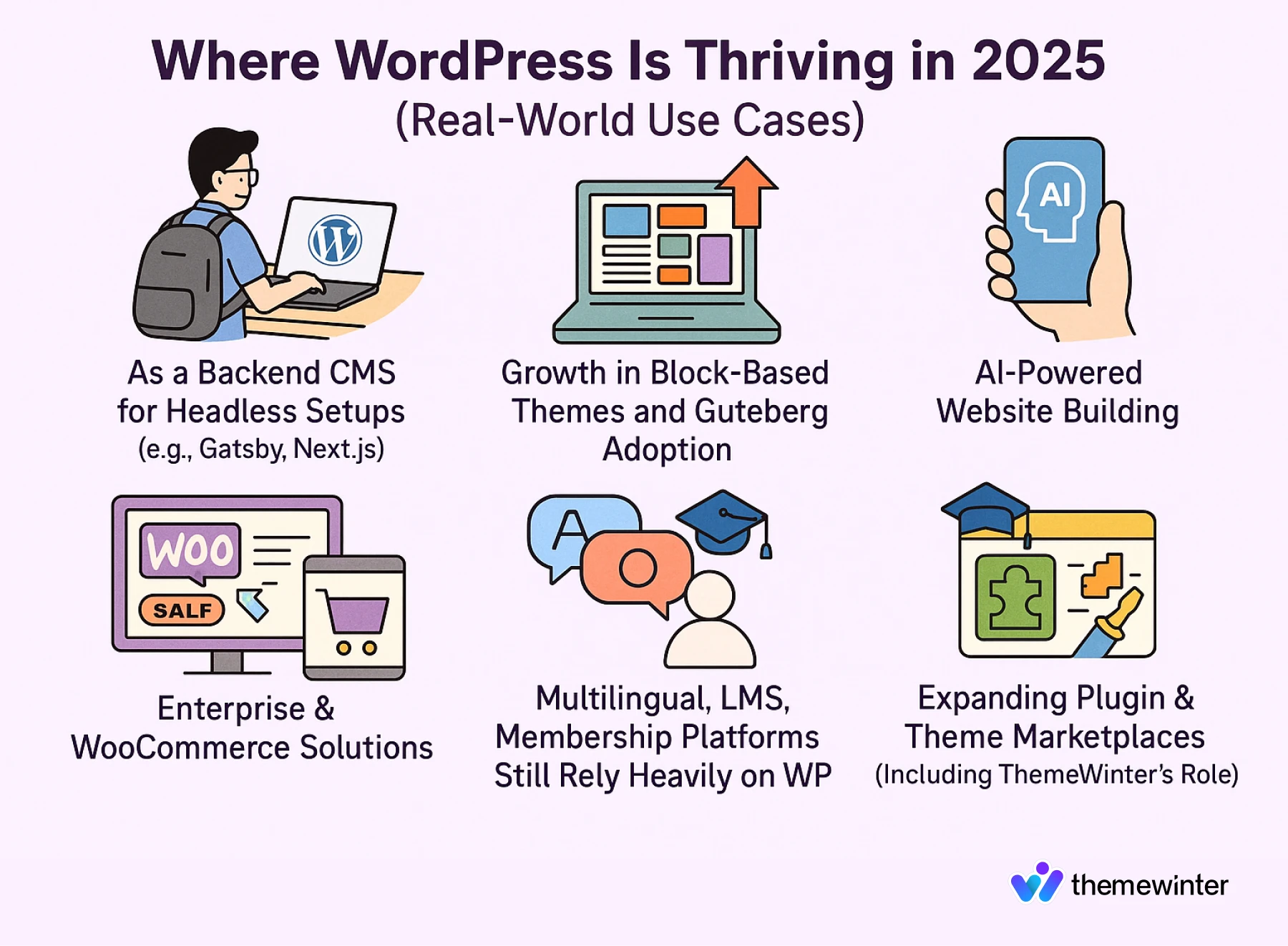
WordPress may not be trendy like some new tools, but it’s still winning in many real-world situations. Let’s look at where it’s working well, right now.
As a backend CMS for headless setups
As we mentioned earlier, more developers are now using WordPress as a headless CMS, where WordPress is used solely for content. Tools like Sanity or Strapi serve as the backend, while the frontend is built using frameworks such as Next.js, Nuxt, or Gatsby.
This setup gives teams more control over site speed and user experience, while still benefiting from WordPress’s flexible admin dashboard. Content editors can stick with a familiar interface, while developers build faster, more custom frontends.
Growth in block-based themes and Gutenberg adoption
The block editor is now central to the development of new WordPress themes. Themes like Frost, Spectra One, and the core Twenty Twenty-Five are fully block-based, giving users more control over layout and design without needing additional plugins.
Instead of relying on third-party page builders, users can now manage layouts, colors, and global styles directly from the WordPress interface. Blocks also make it easier to reuse and manage consistent designs across pages.
💡Read also: Top 15 Best WordPress Themes
AI-powered website building is taking shape
AI is becoming an integral part of how people build and manage WordPress sites, not just as a plugin, but as an integrated part of the process.
Tools like Spectra AI let you create complete sections and layouts using simple prompts, while Bertha AI works inside the editor to help with writing, tone, and content suggestions. Some themes and builders like Divi are also incorporating AI-powered layout helpers that streamline setup based on your content or industry.
It’s not just about saving time. For freelancers, small teams, or anyone without a technical background, these tools make it easier to turn an idea into a real website while still maintaining the flexibility that WordPress is known for.
Enterprise & WooCommerce solutions
Larger businesses continue to utilize WordPress for complex websites, including internal portals, multilingual setups, and extensive online stores. WooCommerce provides them with a flexible eCommerce system that integrates seamlessly with the rest of their WordPress tools.
Multilingual, LMS, and membership platforms still rely heavily on WP
WordPress remains a top choice for sites that need advanced functionality:
- Multilingual content (using WPML, TranslatePress, or Polylang)
- Online courses (with LMS plugins like Tutor LMS)
- Memberships and gated content (via MemberPress, Restrict Content Pro)
This is where the plugin ecosystem shines. Users can build tailored solutions without having to reinvent the wheel.
Expanding plugin & theme marketplaces
Plugin and theme developers continue to build for WordPress. New tools come out every month. Teams like Arraytics (recently launched Booktics) continue to release plugins that help users manage events, bookings, and more, all without leaving WordPress.
While the spotlight may be elsewhere, WordPress is still busy solving real-world problems.
💡Read also: 7 Best WordPress Event Management Plugins to Try
Key challenges WordPress must overcome
WordPress is still growing and improving, but it’s not perfect. After 20 years, it comes with some built-in challenges, and as the web changes, those gaps stand out more.
Here are a few areas where WordPress still needs work.
- Better onboarding for new users: The initial experience with WordPress remains rough. The dashboard feels dated. There are too many settings. It’s easy to get lost. Competing tools make it easier to start WordPress; it needs to catch up here.
- Old code slows things down: To remain compatible with older themes and plugins, WordPress retains a significant amount of legacy code. This helps with stability, but it also complicates things for developers who want to use newer tools or build modern features.
- Setting up WordPress isn’t easy for beginners: Getting started with WordPress still requires effort. You need to pick a host, choose a theme, install plugins, and learn how to use the editor. Compared to tools like Wix or Webflow, it can feel like too many steps for someone new to the process.
- Plugin conflicts and slow sites: The plugin system gives you lots of freedom, but it also causes problems such as some plugins slowing down your site, others not working well together, and sometimes updates breaking things without warning. Many users end up resolving issues through trial and error or by searching community forums.
- Too many ways to build the same site: There’s no single “right” way to build with WordPress. That’s flexible, but it can also cause confusion. Two developers might create the same site in entirely different ways, which makes teamwork, support, and updates harder to manage.
- The block editor isn’t for everyone: Gutenberg has improved, but not everyone is fond of it. Some prefer the traditional approach to building themes with PHP. Others find blocks hard to use for complex layouts. Switching between classic themes and block themes can also feel messy. There’s still work to do to make the editor feel consistent for everyone.
What’s next: WordPress in the future
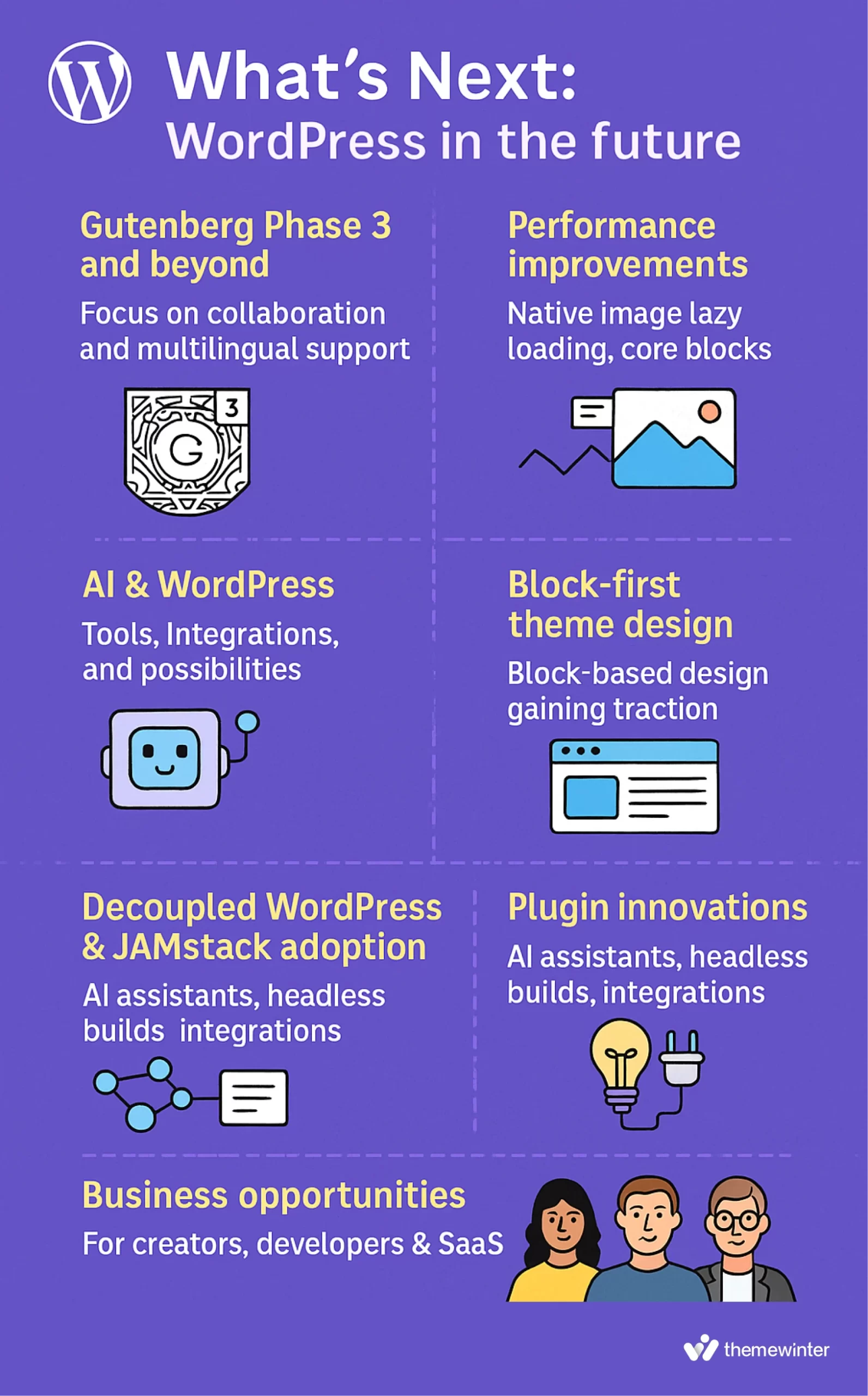
WordPress is actively changing to meet modern web standards, and there are already visible examples of how those changes are being used in the real world.
Here’s what’s coming and how it’s already taking shape.
Gutenberg Phase 3 and beyond
The Gutenberg project is now in Phase 3, which brings in real-time collaboration. This means users will soon be able to edit posts or pages together, similar to how Google Docs works.
This feature is particularly useful for teams, agencies, and content creators who collaborate in groups. Alongside this, the editing experience continues to improve with cleaner UI, better tools for pattern management, and more layout control.
Performance improvements
Speed remains a significant focus for WordPress. Core updates now include features such as lazy loading for images, improved handling of CSS and JavaScript, and performance enhancements for blocks.
These changes help pages load faster without relying too heavily on caching plugins or specialized hosting setups. There’s also a greater emphasis on meeting Core Web Vitals, which benefits both search rankings and user experience.
AI & WordPress: tools, integrations, and possibilities
AI is starting to show up more in WordPress tools. Some plugins now offer content help, image generation, or even chatbots—right inside the dashboard. For example, Divi AI helps with layout and copy suggestions, ShortPixel AI handles image optimization, and Eventin has built-in AI for event automation.
You’ll also find tools like CodeWP for writing custom code and AI chatbots that can guide visitors or answer questions. These features are still new, but they’re making it easier to create content, manage tasks, and speed up your workflow without leaving WordPress.
Block-first theme design is gaining traction
Themes built entirely with blocks are becoming more common. These are designed with the new Site Editor in mind, allowing users to change layouts, styles, and even templates without needing to touch code.
Block-first design is starting to replace older methods of customizing headers and footers through PHP. It’s also making it easier for users to launch sites that look polished and modern with minimal setup.
Business opportunities for creators, developers & SaaS
The WordPress ecosystem is evolving, and new models are emerging. StudioPress, for example, moved from selling just themes to offering complete site kits with hosting under WP Engine.
Tools like MemberPress and Tutor LMS enable creators to run paid courses and communities directly within WordPress. Even at ThemeWinter, we are building plugins tailored to specific needs, including event management and restaurant management through WPCafe, allowing users to get more focused tools right out of the box.
💡Read also: 7 Best WordPress Event Plugins to Try in 2025
Expert opinions: What WordPress leaders are saying
To gain a better understanding of where WordPress is headed, it’s helpful to hear directly from those who are shaping its direction or working with it on a daily basis.
Here are a few insights from notable voices in the WordPress space.
🗣️ Matt Mullenweg (Co-founder of WordPress, CEO of Automattic)
In the 2024 State of the Word address, Matt shared a clear vision of where WordPress is heading:
He also discussed the ongoing collaboration focus within Gutenberg Phase 3, signifying a shift toward real-time, team-based editing.
🗣️ Joost de Valk (Founder of Yoast SEO)
Joost regularly highlights the need for performance and modernization, while affirming WordPress’s place in the web ecosystem. In his December 2024 post on the WordPress roadmap:
He firmly states that WordPress isn’t disappearing, but it must catch up with performance expectations to maintain relevance.
🗣️ Brian Gardner (Founder of StudioPress, Developer Advocate at WP Engine)
In a WP Engine blog post, Brian highlights how block and full site editing represent more than new features—they are a fundamental change in website-building:
Brian has been an advocate for block-based design and encourages developers to lean into this new era of WordPress theming.
🗣️ GravityKit Community Survey (2025 AI in WordPress)
A recent GravityKit survey of over 100 WordPress users reveals a split: users are “Rarely,” “Sometimes,” or “Often” using AI tools in WordPress—but only a small fraction say they never use them. One expert sums it up:
Final verdict: WordPress is not dying—it’s evolving
So, is WordPress dying? No, WordPress is not dying.
What we’re seeing isn’t a slow fade, it’s a shift. WordPress in 2025 isn’t the same as it was five or ten years ago, and that’s a good thing. The web has changed, and WordPress is adapting in response.
Yes, some users are exploring other platforms. Simpler tools are often more effective for specific use cases, and newer technologies, such as headless CMS or no-code builders, are gaining traction. That doesn’t mean WordPress is obsolete; it means the market is growing and becoming more diverse.
At the same time, WordPress is still:
- Powering hundreds of millions of websites
- Being actively developed, with new features in every release
- Supporting a massive global community of developers, creators, and businesses
- Offering flexibility that closed platforms simply can’t match
With improvements in block editing, performance, AI integration, and headless architecture, it continues to meet the needs of modern web projects.
If you’re considering using WordPress or wondering if it’s still worth investing in, it’s helpful to think in the long term. It’s not the newest tool in the box, but it’s one of the most dependable. And it continues to evolve to meet the future of the web.
💡Read also: How to Get Sponsorships for an Event
FAQs about the state of WordPress
Is WordPress still worth using in 2025?
Yes. WordPress still powers over 43% of websites and is used by blogs, businesses, online stores, and more. It’s actively maintained, and the block editor (Gutenberg) continues to improve.
Why do people think WordPress is outdated?
Some users find the WordPress dashboard less modern compared to visual builders like Webflow or Wix. Others cite plugin overload, legacy code, and a steeper learning curve as reasons why it feels outdated.
Is WordPress good for beginners in 2025?
It depends. WordPress has a learning curve, especially when setting up themes and plugins. But many hosting providers offer one-click installs, and modern block themes make things easier than before.
What are the latest WordPress trends in 2025?
In 2025, WordPress is seeing significant growth in block-based themes, headless CMS setups, real-time collaboration tools via Gutenberg Phase 3, and AI-powered plugins for content and design.
Is WooCommerce still popular for eCommerce?
Yes. WooCommerce remains the most used eCommerce platform on WordPress, powering over 25% of all online stores. It provides unmatched flexibility and full ownership compared to hosted platforms.
Who should still use WordPress in 2025?
Agencies, bloggers, educators, and businesses running content-heavy or customizable websites continue to benefit from WordPress. It offers a flexible ecosystem with thousands of plugins and complete control over design and functionality.
What are some good alternatives to WordPress?
If you want a simple setup with fewer options, tools like Shopify, Webflow, Wix, Ghost, and Framer might be a better fit. They work well for small sites, newsletters, or quick builds.
Can WordPress keep up with AI and modern trends?
Yes. WordPress plugins are beginning to incorporate AI features, including content suggestions, layout tools, and writing assistance. The platform also supports headless setups, block-first design, and more.
Is WordPress that bad?
Not really. Like any tool, WordPress has pros and cons. It can feel complex at first and sometimes needs more care than newer platforms. However, it remains robust, flexible, and supports millions of sites. For many people, it’s the right choice.
What is the future of WordPress careers?
WordPress careers are still strong in 2025. Developers, designers, marketers, and content writers are in demand, especially those who understand block themes, WooCommerce, and performance optimization. As WordPress evolves, so do the job opportunities around it.


